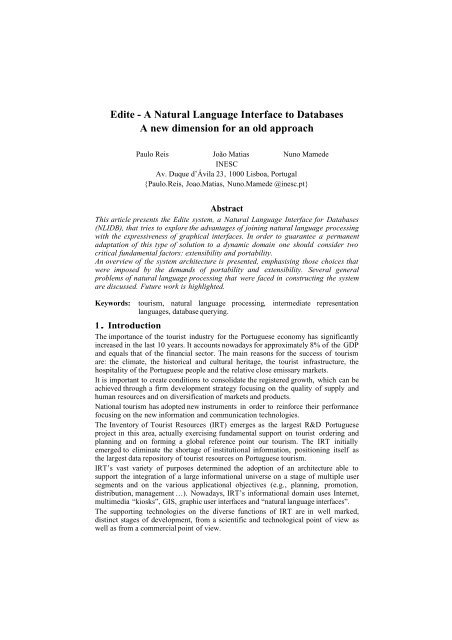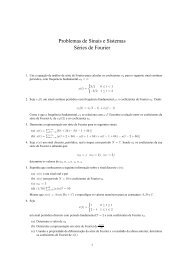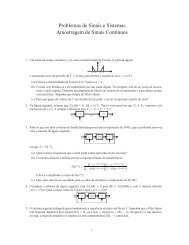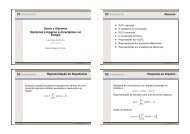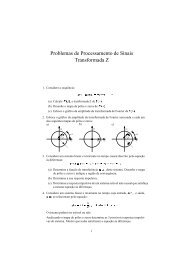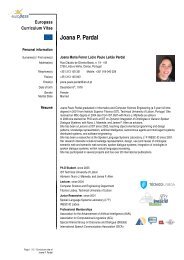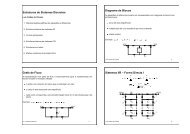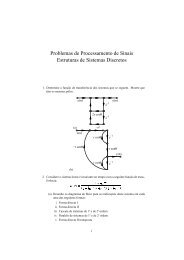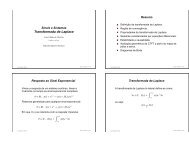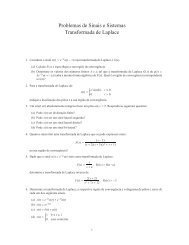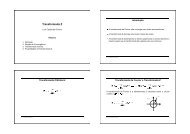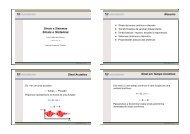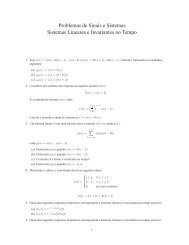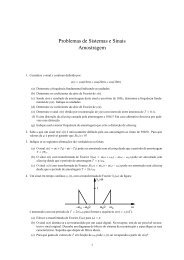A natural language interface to databases - the Spoken Language ...
A natural language interface to databases - the Spoken Language ...
A natural language interface to databases - the Spoken Language ...
You also want an ePaper? Increase the reach of your titles
YUMPU automatically turns print PDFs into web optimized ePapers that Google loves.
Edite - A Natural <strong>Language</strong> Interface <strong>to</strong> Databases<br />
A new dimension for an old approach<br />
Paulo Reis João Matias Nuno Mamede<br />
INESC<br />
Av. Duque d’Ávila 23, 1000 Lisboa, Portugal<br />
{Paulo.Reis, Joao.Matias, Nuno.Mamede @inesc.pt}<br />
Abstract<br />
This article presents <strong>the</strong> Edite system, a Natural <strong>Language</strong> Interface for Databases<br />
(NLIDB), that tries <strong>to</strong> explore <strong>the</strong> advantages of joining <strong>natural</strong> <strong>language</strong> processing<br />
with <strong>the</strong> expressiveness of graphical <strong>interface</strong>s. In order <strong>to</strong> guarantee a permanent<br />
adaptation of this type of solution <strong>to</strong> a dynamic domain one should consider two<br />
critical fundamental fac<strong>to</strong>rs: extensibility and portability.<br />
An overview of <strong>the</strong> system architecture is presented, emphasising those choices that<br />
were imposed by <strong>the</strong> demands of portability and extensibility. Several general<br />
problems of <strong>natural</strong> <strong>language</strong> processing that were faced in constructing <strong>the</strong> system<br />
are discussed. Future work is highlighted.<br />
Keywords:<br />
<strong>to</strong>urism, <strong>natural</strong> <strong>language</strong> processing, intermediate representation<br />
<strong>language</strong>s, database querying.<br />
1. Introduction<br />
The importance of <strong>the</strong> <strong>to</strong>urist industry for <strong>the</strong> Portuguese economy has significantly<br />
increased in <strong>the</strong> last 10 years. It accounts nowadays for approximately 8% of <strong>the</strong> GDP<br />
and equals that of <strong>the</strong> financial sec<strong>to</strong>r. The main reasons for <strong>the</strong> success of <strong>to</strong>urism<br />
are: <strong>the</strong> climate, <strong>the</strong> his<strong>to</strong>rical and cultural heritage, <strong>the</strong> <strong>to</strong>urist infrastructure, <strong>the</strong><br />
hospitality of <strong>the</strong> Portuguese people and <strong>the</strong> relative close emissary markets.<br />
It is important <strong>to</strong> create conditions <strong>to</strong> consolidate <strong>the</strong> registered growth, which can be<br />
achieved through a firm development strategy focusing on <strong>the</strong> quality of supply and<br />
human resources and on diversification of markets and products.<br />
National <strong>to</strong>urism has adopted new instruments in order <strong>to</strong> reinforce <strong>the</strong>ir performance<br />
focusing on <strong>the</strong> new information and communication technologies.<br />
The Inven<strong>to</strong>ry of Tourist Resources (IRT) emerges as <strong>the</strong> largest R&D Portuguese<br />
project in this area, actually exercising fundamental support on <strong>to</strong>urist ordering and<br />
planning and on forming a global reference point our <strong>to</strong>urism. The IRT initially<br />
emerged <strong>to</strong> eliminate <strong>the</strong> shortage of institutional information, positioning itself as<br />
<strong>the</strong> largest data reposi<strong>to</strong>ry of <strong>to</strong>urist resources on Portuguese <strong>to</strong>urism.<br />
IRT’s vast variety of purposes determined <strong>the</strong> adoption of an architecture able <strong>to</strong><br />
support <strong>the</strong> integration of a large informational universe on a stage of multiple user<br />
segments and on <strong>the</strong> various applicational objectives (e.g., planning, promotion,<br />
distribution, management …). Nowadays, IRT’s informational domain uses Internet,<br />
multimedia “kiosks”, GIS, graphic user <strong>interface</strong>s and “<strong>natural</strong> <strong>language</strong> <strong>interface</strong>s”.<br />
The supporting technologies on <strong>the</strong> diverse functions of IRT are in well marked,<br />
distinct stages of development, from a scientific and technological point of view as<br />
well as from a commercial point of view.
This article intends <strong>to</strong> approach and deal with <strong>the</strong> problem of integrating an advanced<br />
technology, <strong>the</strong> so-called plain <strong>language</strong> <strong>interface</strong>s for <strong>databases</strong>, in<strong>to</strong> systems with a<br />
complex architecture.<br />
2. Motivation<br />
One of <strong>the</strong> main characteristics of multimedia kiosks is <strong>the</strong>ir familiar visual<br />
appearance, reducing <strong>the</strong> complexity of communication between man and machine <strong>to</strong><br />
a minimum. The anthroponomical synchronisation of Image, Video, Audio and Text<br />
is one of <strong>the</strong> crucial fac<strong>to</strong>rs <strong>to</strong> “seduce” <strong>the</strong> user in<strong>to</strong> wanting <strong>to</strong> experiment <strong>the</strong><br />
system. Ano<strong>the</strong>r fundamental characteristic is <strong>the</strong> emergence of <strong>the</strong> utility. The user<br />
must feel, when using <strong>the</strong> system for <strong>the</strong> first time, that it can be useful. This is only<br />
possible with a well designed <strong>interface</strong> where <strong>the</strong> information can be easily accessed<br />
without having <strong>to</strong> learn ano<strong>the</strong>r vast and complex communication <strong>language</strong> (<strong>the</strong> one<br />
used by <strong>the</strong> system).<br />
In spite of <strong>the</strong> large variety of existing systems <strong>the</strong>re is not yet a standard for <strong>the</strong>se<br />
<strong>interface</strong>s. This causes <strong>the</strong> user <strong>to</strong> fully understand what <strong>the</strong> system does, only after a<br />
certain amount of time. Ano<strong>the</strong>r critic one could have on this method of interaction<br />
has <strong>to</strong> do with <strong>the</strong> fact that in a traditional system, with navigation through several<br />
successive windows, one can not always get <strong>the</strong> needed information. This occurs<br />
ei<strong>the</strong>r because it does not exist (and <strong>the</strong> system is not able <strong>to</strong> inform <strong>the</strong> user on this)<br />
or because <strong>the</strong> user does not know <strong>the</strong> system <strong>language</strong> well enough <strong>to</strong> extract <strong>the</strong><br />
information in question (it may take <strong>to</strong>o many steps <strong>to</strong> get <strong>the</strong>re).<br />
What could be <strong>the</strong> best browsing alternative that passes beyond <strong>the</strong> above mentioned<br />
limitation? The answer could be a NLIDB.<br />
The evolution of technology has caused a continous development of NLIDBs,<br />
especially in <strong>the</strong> area of <strong>natural</strong> <strong>language</strong> processing, exploring architectures that<br />
transform <strong>the</strong> NLIDBs in<strong>to</strong> relational agents, and integrating <strong>language</strong>s and graphics<br />
that explore <strong>the</strong> advantages of both modalities [1,6].<br />
In order <strong>to</strong> guarantee a permanent adaptation of this type of solution <strong>to</strong> a dynamic<br />
domain one should consider two critical fundamental fac<strong>to</strong>rs: extensibility and<br />
portability [9]. On <strong>the</strong> one hand, a product like a NLIDB has <strong>to</strong> guarantee <strong>the</strong> ease <strong>to</strong><br />
increase <strong>the</strong> linguistic coverage related with <strong>the</strong> domain, without requiring a vast<br />
technical knowledge of <strong>the</strong> <strong>natural</strong> <strong>language</strong>. On <strong>the</strong> o<strong>the</strong>r hand, <strong>the</strong> system has <strong>to</strong><br />
guarantee <strong>the</strong> portability <strong>to</strong> o<strong>the</strong>r <strong>databases</strong>, minimising <strong>the</strong> number of changes.<br />
If <strong>the</strong> above mentioned fac<strong>to</strong>rs are indispensable for <strong>the</strong> development of <strong>the</strong> system<br />
whilst a product, we will have <strong>to</strong> guarantee <strong>the</strong> emergence of <strong>the</strong> utility. We believe<br />
that in order <strong>to</strong> achieve this, three fac<strong>to</strong>rs are indispensable: a good linguistic<br />
coverage, <strong>the</strong> comprehension of <strong>the</strong> domain (ideally an <strong>interface</strong> of this type can use<br />
all of <strong>the</strong> existing information in <strong>the</strong> database) and great interaction with <strong>the</strong> user.<br />
Bearing this fac<strong>to</strong>rs in mind, INESC has been developing Edite, a multimodal<br />
<strong>interface</strong>, since 1995. This <strong>interface</strong> tries <strong>to</strong> combine <strong>the</strong> advantages of <strong>the</strong> <strong>natural</strong><br />
<strong>language</strong> with <strong>the</strong> expressiveness of <strong>the</strong> graphical <strong>interface</strong>s.<br />
Chapter 3 presents <strong>the</strong> NLIDB architecture of <strong>the</strong> Edite system, describing <strong>the</strong><br />
principle modules. Chapter 4 will present some of <strong>the</strong> options for a future<br />
development. Chapter 5 will present <strong>the</strong> main conclusions of this work.
3. An overview of Edite<br />
3.1. Introduction<br />
Edite is a multi-lingual (Portuguese, French, English, Spanish) <strong>natural</strong> <strong>language</strong><br />
front-end for relational <strong>databases</strong>. It answers written questions about <strong>to</strong>urism resources<br />
by transforming <strong>the</strong>m in<strong>to</strong> SQL queries. The answer depends on <strong>the</strong> type of question.<br />
It can be a nominal list of resources, text, images or graphics. At present, <strong>the</strong> database<br />
contains 53000 <strong>to</strong>urism resources, arranged on 253 distinct types, corresponding <strong>to</strong><br />
209 tables.<br />
The main goal of a NLIDB is <strong>to</strong> provide users with <strong>the</strong> capability of, in an efficient<br />
alternative way, obtaining information s<strong>to</strong>red in <strong>the</strong> database [5]. The user is not<br />
required <strong>to</strong> learn an artificial communication <strong>language</strong> being possible <strong>to</strong> formulate <strong>the</strong><br />
question in his own native <strong>language</strong>. The system building up was driven by two<br />
main objectives: (a) <strong>the</strong> exploration of a new technology in an existing context, i.e.<br />
by exploring how this technology can be used <strong>to</strong> increase <strong>the</strong> efficiency of current<br />
processes. The technology should also work as a new motive of attraction. We could<br />
integrate this in<strong>to</strong> multimedia kiosks, but we can foresee <strong>the</strong> adequacy <strong>to</strong> o<strong>the</strong>r<br />
information supports, like e.g. Internet; (b) <strong>the</strong> advantages NLIDBs have, compared<br />
<strong>to</strong> o<strong>the</strong>rs <strong>interface</strong>s like formal query <strong>language</strong>s, form-based <strong>interface</strong>s and graphical<br />
<strong>interface</strong>s: (1) <strong>the</strong> user is not required <strong>to</strong> learn an artificial communication <strong>language</strong> <strong>to</strong><br />
use <strong>the</strong> system's potentiality. This does not mean that <strong>the</strong>re is no need for some<br />
information (training) about <strong>the</strong> system's functionality (linguistic coverage, <strong>language</strong>'s<br />
domain); (2) <strong>the</strong>re are kinds of questions (e.g. questions involving negation or<br />
quantification) that can be easily expressed in <strong>natural</strong> <strong>language</strong>, but that seem difficult<br />
(or at least tedious) <strong>to</strong> express using graphical or form-based <strong>interface</strong>s. For example,<br />
“What Lisbon's hotels are rated over 3 stars?” (numerical quantification), or “Which<br />
are <strong>the</strong> Algarve's golf courses without a driving range?” (negation), can be easy<br />
expressed in <strong>natural</strong> <strong>language</strong>, but <strong>the</strong>y would be difficult <strong>to</strong> express in most<br />
graphical or form-based <strong>interface</strong>s; (3) <strong>the</strong> system will support anaphoric and elliptical<br />
expressions. NLIDBs of this kind allow <strong>the</strong> use of very brief, under-specified<br />
questions, where <strong>the</strong> meaning of each question is complemented by <strong>the</strong> discourse<br />
context. In o<strong>the</strong>r <strong>interface</strong>s this notion of discourse context is usually not supported.<br />
3.2. System Architecture<br />
The system architecture (see Figure 1) is based on intermediate representation<br />
<strong>language</strong>s, where <strong>the</strong> <strong>natural</strong> <strong>language</strong> question is transformed in<strong>to</strong> an intermediate<br />
logical query (LIL), before <strong>the</strong> final translation <strong>to</strong> a SQL query. This <strong>language</strong><br />
expresses <strong>the</strong> meaning of <strong>the</strong> sentence in terms of high-level concepts, independent of<br />
<strong>the</strong> database structure [3,4].<br />
The system architecture can be seen as being made of two big modules. The first<br />
module controls <strong>the</strong> <strong>natural</strong> <strong>language</strong> processing (linguistic component), where a<br />
question is submitted and successively transformed (morphological, syntactic, and<br />
semantic analysis), obtaining at <strong>the</strong> end of this process one or more LIL expressions.<br />
These expressions correspond <strong>to</strong> <strong>the</strong> possible interpretations of <strong>the</strong> initial question.<br />
Given <strong>the</strong> dimension of <strong>the</strong> domain and <strong>the</strong> flexibility of <strong>the</strong> <strong>natural</strong> <strong>language</strong>, <strong>the</strong>re<br />
exist usually, several interpretations for <strong>the</strong> same question (<strong>the</strong> same happens with <strong>the</strong><br />
spoken <strong>language</strong>).<br />
The second component is in charge of <strong>the</strong> connection with <strong>the</strong> database, translating<br />
<strong>the</strong> LIL expressions <strong>to</strong> Structured Query <strong>Language</strong> (SQL) expressions (using mapping
tables, see 3.3.4) and sending <strong>the</strong>m <strong>to</strong> <strong>the</strong> Data Base Management System (DBMS)<br />
<strong>to</strong> produce <strong>the</strong> answers.<br />
The main advantage of this architecture is <strong>the</strong> complete separation between <strong>the</strong><br />
linguistic component and <strong>the</strong> database knowledge. The portability of <strong>the</strong> system <strong>to</strong><br />
ano<strong>the</strong>r relational database is guaranteed by <strong>the</strong> configuration of <strong>the</strong> mapping module.<br />
Of course, <strong>the</strong>re will always be o<strong>the</strong>r modules <strong>to</strong> configure, because of <strong>the</strong> linguistic<br />
coverage but <strong>the</strong> main work remains on <strong>the</strong> mapping tables.<br />
3.3. System Components<br />
Morphological Analysis<br />
The morphological analysis module is an extension of Ispell (dictionary support<br />
usually employed by UNIX users) and allows one <strong>to</strong> obtain information about <strong>the</strong><br />
words that form <strong>the</strong> sentence. For this purpose, it uses a dictionary with <strong>the</strong> root form<br />
of words and one affix file which contains <strong>the</strong> construction rules. Thus, it is possible<br />
<strong>to</strong> get <strong>the</strong> morphologic and semantic information of all <strong>the</strong> words of a family;<br />
however, this information does not have an explicit representation on <strong>the</strong> dictionary<br />
[2,10].<br />
Each entry of <strong>the</strong> dictionary holds, besides <strong>the</strong> root, <strong>the</strong> construction rules that can be<br />
applied, syntactic and semantic information. E.g. <strong>the</strong> words hotel and lodge have<br />
<strong>the</strong> following entries:<br />
hotel/CAT=nc,SEM=hotel(X),TYPE=HOTEL/p/<br />
lodge/CAT=v,SEM=lodge(X,Y),TYPE=IND,T=inf,TR=t/XYPLSM/<br />
About <strong>the</strong> word hotel, we have <strong>the</strong> information that it is an ordinary name that<br />
could be conjugated in <strong>the</strong> plural form. Its semantics is hotel(X) where X is a<br />
variable of <strong>the</strong> type HOTEL.<br />
About <strong>the</strong> lodge word we have <strong>the</strong> information that it is a transitive verb, and one<br />
can apply <strong>the</strong> construction rules XYPLSM; <strong>the</strong> semantics of <strong>the</strong> word is<br />
lodge(X,Y) where X and Y are variables of an indeterminate type.<br />
The syntactic and semantic information are used in <strong>the</strong> correspondent analysis. It is<br />
important <strong>to</strong> remark that <strong>the</strong>re may exist equal words in <strong>the</strong> dictionary that have<br />
different semantics. This fact is extremely important for <strong>the</strong> semantic analysis.
Question<br />
Dictionary<br />
Morphological<br />
Analysis<br />
Information About<br />
Words<br />
Syntactic<br />
Rules<br />
Syntactic<br />
Analysis<br />
Conceptual Model<br />
Type<br />
Hierarchy<br />
Semantic<br />
Rules<br />
Conceptual<br />
Constraints<br />
Syntax Structure<br />
(parse tree)<br />
Semantic<br />
Analysis<br />
Logical Query<br />
Mapping<br />
Tables<br />
Translation<br />
LIL/SQL<br />
SQL Query<br />
DBMS<br />
Answer<br />
Figure 1 - The Edite Architecture<br />
Syntactic Analysis<br />
The syntactic analysis is based on <strong>the</strong> chart-parser technique, using a context free<br />
grammar and <strong>the</strong> Earley algorithm [1,7]. The result of this module is a set of parse<br />
trees, corresponding <strong>to</strong> <strong>the</strong> possible syntactical interpretations of <strong>the</strong> sentence.<br />
One remark about this phase is <strong>the</strong> relaxation of some grammatical rules. This means<br />
that certain “less correct” sentences are also accepted and interpreted by <strong>the</strong> system.<br />
This was motivated by <strong>the</strong> evidence that those are currently used sentences.<br />
Semantic Analysis<br />
The final goal of NLIDB is <strong>the</strong> determination of <strong>the</strong> meaning of a sentence. In our<br />
case, and in <strong>the</strong> context of a database, that meaning is given by <strong>the</strong> SQL expression<br />
obtained after processing <strong>the</strong> initial statement (a question).<br />
To obtain that expression, it is necessary <strong>to</strong> determine its meaning, usually<br />
represented in a logical form. In our case, we use <strong>the</strong> LIL <strong>language</strong> [14], similar <strong>to</strong> <strong>the</strong><br />
First Order Predicate Calculus.
The sentence “Which is <strong>the</strong> telephone number of <strong>the</strong> Ritz hotel?” 1<br />
is represented in<br />
LIL as:<br />
hotel(Ritz-hotel), telephone (_11), of(_11, Ritz-hotel).<br />
We will describe, very briefly, <strong>the</strong> LIL generation process (<strong>the</strong> space available being<br />
insufficient for a full description), concentrating on <strong>the</strong> interaction with <strong>the</strong> conceptual<br />
model. [10] The translation <strong>to</strong> LIL is similar <strong>to</strong> <strong>the</strong> syntactic analysis, using a<br />
dictionary and rules.<br />
The semantic dictionary contains <strong>the</strong> words sense, called unit of meaning. When <strong>the</strong><br />
meaning of a word is domain dependent it has <strong>to</strong> be defined using a logical predicate<br />
[14]. As an example, <strong>the</strong> meaning of <strong>the</strong> word “city” can be described by <strong>the</strong> predicate<br />
is_city(X), and consequently <strong>the</strong> question “Is Lisbon a city?” should be translated<br />
in<strong>to</strong>: is_city(Lisbon).<br />
Besides <strong>the</strong> predicates related with <strong>the</strong> words that are domain dependent , <strong>the</strong>re exist<br />
ano<strong>the</strong>r class of predicates, domain independent, such as <strong>the</strong> logical opera<strong>to</strong>rs (AND,<br />
OR, and NOT) and <strong>the</strong> predicates min, max, inf, sup, and exact.<br />
The semantic rules define <strong>the</strong> relations between <strong>the</strong> meanings of <strong>the</strong> words in a<br />
sentence. Each syntactic rule has a correspondent semantic rule, and for that reason<br />
this process is called rule-by-rule style.<br />
Like syntactic analysis, semantic analysis is compositional, which means that <strong>the</strong><br />
meaning of a constituent is derived solely from <strong>the</strong> meanings of its subconstituents.<br />
Compositional <strong>the</strong>ories have some attractive properties. In particular, interpretations<br />
can be built incrementally from <strong>the</strong> interpretations of subphrases [1].<br />
The semantic analysis process generates several LIL expressions, however, not all<br />
relations are conceptually acceptable in a given domain. The conceptual module is<br />
used <strong>to</strong> help ruling out <strong>the</strong> invalid LIL expressions. We say that a sentence is<br />
conceptually well defined when <strong>the</strong>re are no violations of <strong>the</strong> constraints of <strong>the</strong><br />
domain of discourse. If a sentence does not respect <strong>the</strong> conceptual constraints, <strong>the</strong>n it<br />
is conceptually wrong (nonsense). In [13] we present a formalism for modelling<br />
conceptual constraints. The conceptual module is extremely important because it<br />
invalidates <strong>the</strong> wrong translations performed by <strong>the</strong> semantic analysis, reducing <strong>the</strong><br />
number of LIL expressions that are generated.<br />
The following example shows <strong>the</strong> importance of <strong>the</strong> conceptual module. Suppose that<br />
<strong>the</strong> dictionary contains three resources named Lisbon, a city, a hotel, and a dancing:<br />
Lisbon/CAT=np,SEM=city(X),TIPO=city/p/<br />
Lisbon/CAT=np,SEM=hotel(X),TIPO=hotel/p/<br />
Lisbon/CAT=np,SEM=dancing(X),TIPO=dancing/p/<br />
If asked “Is Lisbon a city?”, during <strong>the</strong> semantic analysis <strong>the</strong> system would try <strong>to</strong><br />
generate <strong>the</strong> following expressions: is_city(Lisbon-city), is_city(Lisbon-city),<br />
is_city(Lisbon-city). However, when <strong>the</strong> conceptual module is requested <strong>to</strong> validate<br />
<strong>the</strong> previous expressions, two of <strong>the</strong>m would be eliminated due <strong>to</strong> <strong>the</strong> constraint<br />
is_city(city) (city represents <strong>the</strong> type of <strong>the</strong> argument). 2<br />
1 In this paper, all <strong>the</strong> english questions and vocabulary were adapted from <strong>the</strong> portuguese<br />
system module.<br />
2 The arguments of a logical predicate correspond <strong>to</strong> a given semantic. In <strong>the</strong> previous<br />
example, is_city would have <strong>to</strong> be declared, in <strong>the</strong> conceptual module, as <strong>the</strong> constraint<br />
is_city(type_city), denoting that <strong>the</strong> argument of <strong>the</strong> predicate has <strong>to</strong> be of type_city<br />
[11,13].
In <strong>the</strong> Edite system types are organised in a hierarchy: a forest of trees, where each<br />
ascendant subsumes its descendants types.<br />
The conceptual model is also used <strong>to</strong> solve o<strong>the</strong>r problems related with <strong>the</strong> scope of<br />
<strong>the</strong> modifiers (adverbial phrases and prepositional phrases). The question “Which are<br />
<strong>the</strong> hotels of Lisbon with air-conditioning?” only has one interpretation, because<br />
“Lisbon does not have air-conditioning”. During <strong>the</strong> syntactic analysis, and due <strong>to</strong><br />
<strong>the</strong> second modifier, two syntactic trees are generated. In one, “with airconditioningr”<br />
is a modifier of <strong>the</strong> noun “hotel” (syntactic rules NP‡ Det N NP PP,<br />
PP‡Det N), in <strong>the</strong> o<strong>the</strong>r, as a modifier of <strong>the</strong> noun “Lisbon” (syntactic rules NP‡<br />
Det N PP, PP‡Det N PP, PP‡ Det N). However, during <strong>the</strong> semantic analysis,<br />
when applying <strong>the</strong> correspondent semantic rules, <strong>the</strong> second interpretation fails, since<br />
<strong>the</strong> predicate with(Lisbon, air-conditioning), is not validated by <strong>the</strong> conceptual<br />
model. Consequently, a unique LIL expression is generated at <strong>the</strong> end of <strong>the</strong><br />
interpretation process. Note that <strong>the</strong> question “Which are <strong>the</strong> hotels with a bar in<br />
Lisbon?” has two possible interpretations.<br />
LIL-SQL Translation<br />
The LIL-SQL transla<strong>to</strong>r [12] is based upon several mapping tables, which are highly<br />
dependent on <strong>the</strong> database organisation. This process is very efficient and, more<br />
importantly, it allows Edite <strong>to</strong> be used with any o<strong>the</strong>r relational database, being only<br />
necessary <strong>to</strong> define new mapping tables.<br />
The question “Has hotel Berna a swimming pool?” is translated <strong>to</strong> <strong>the</strong> following LIL<br />
expression: hotel(Berna-hotel), have(Berna-hotel,swimming-pool). This last<br />
expression is <strong>the</strong>n transformed in<strong>to</strong> SQL:<br />
SELECT FROM hotel B<br />
WHERE B.cod_type_abord=16 AND B.cod_hotel_gr=1 AND<br />
B.cod_rec_turist=12234 AND B.swimmpool > 0”<br />
The answer is produced by ano<strong>the</strong>r system, in which <strong>the</strong> <strong>natural</strong> <strong>language</strong> package is<br />
included. It is this system that presents <strong>the</strong> answers using nominal lists of <strong>to</strong>urism<br />
resources, texts, and graphics.<br />
The relations used in LIL cannot be directly translated in<strong>to</strong> database relations. In <strong>the</strong><br />
systems that use a similar architecture, <strong>the</strong> database is defined taking in<strong>to</strong> account <strong>the</strong><br />
<strong>natural</strong> <strong>language</strong> processing. Since <strong>the</strong> possibility of expressing questions in <strong>natural</strong><br />
<strong>language</strong> was only considered when <strong>the</strong> database was defined and full loaded, we were<br />
forced <strong>to</strong> define meta-relations <strong>to</strong> map <strong>the</strong> LIL relations in<strong>to</strong> <strong>the</strong> database<br />
organisation. This approach does not degrade <strong>the</strong> response time, because <strong>the</strong> time<br />
spent during this last translation step is very small when compared with <strong>the</strong> previous<br />
modules.<br />
4. Future Work<br />
At <strong>the</strong> present moment <strong>the</strong> project is in <strong>the</strong> final stage of conception and pro<strong>to</strong>typing.<br />
In fact <strong>the</strong> Portuguese pro<strong>to</strong>type is ready <strong>to</strong> be integrated in <strong>the</strong> experimental version<br />
of <strong>the</strong> entire system. On <strong>the</strong> o<strong>the</strong>r hand, <strong>the</strong> dictionaries necessary for <strong>the</strong> multi<strong>language</strong><br />
processing are being embedded in <strong>the</strong> application. Therefore, in <strong>the</strong><br />
beginning of 1997 <strong>the</strong> product will be available for testing in <strong>the</strong> WEB and in <strong>the</strong><br />
Portuguese Tourism Information Network.
In <strong>the</strong> future, we intend <strong>to</strong> extend Edite in order <strong>to</strong> achieve <strong>the</strong> following goals:<br />
• Resolution of several <strong>language</strong> phenomenons such as anaphora and ellipse with<br />
<strong>the</strong> purpose of increasing <strong>the</strong> communication speed. E.g. “Which are <strong>the</strong> country<br />
clubs in Albufeira area? And which are <strong>the</strong> hotels?”.<br />
• Treatment of negation. E.g. “Which campings do not require a camping licence?”<br />
• Handling temporal questions. In this type of questions, <strong>the</strong> numbers, dates and<br />
times have <strong>to</strong> be carefully treated. E.g. “Is <strong>the</strong> Jeronimos monastery open on<br />
Saturdays?” , “In Lisbon, what are <strong>the</strong> churches open between 7 am. and 10<br />
am.?”<br />
• Semi-au<strong>to</strong>matization of <strong>the</strong> fulfilment data. The goal is construct a software <strong>to</strong>ol,<br />
Domains Edi<strong>to</strong>r, that partially au<strong>to</strong>mates <strong>the</strong> information augmenting process; by<br />
information we mean dictionaries, conceptual model and mapping tables. This<br />
acquisition component is crucial <strong>to</strong> <strong>the</strong> success of a portable system. This <strong>to</strong>ol<br />
allows a better management with fewer demands on (i) <strong>the</strong> knowledge of <strong>the</strong><br />
system’s internal workings; (ii) <strong>the</strong> intricacies of <strong>the</strong> grammar; (iii) computational<br />
linguistics in general.<br />
• The development of techniques for generating co-operative responses. Nowadays,<br />
if <strong>the</strong> user asks “What are <strong>the</strong> hotels in Marinhais?”, <strong>the</strong> system will return an<br />
empty list. In <strong>the</strong> future, we expect that <strong>the</strong> system answers with: “There are no<br />
hotels in Marinhais.”; next it can present information related <strong>to</strong> o<strong>the</strong>r types of<br />
lodging. The idea is <strong>to</strong> progress from <strong>the</strong> actual answers <strong>to</strong> co-operative ones.<br />
• Natural <strong>language</strong> generation.<br />
• Due <strong>to</strong> <strong>the</strong> evolution of signal processing technology, namely digital speech<br />
recognition, it will be possible <strong>to</strong> integrate, in <strong>the</strong> future, a voice analyser in this<br />
system. This will allow <strong>the</strong> establishment of a direct oral dialogue between <strong>the</strong><br />
final user and <strong>the</strong> system.<br />
5. Conclusions<br />
In spite of <strong>the</strong> linguistic limitations, <strong>the</strong> system is powerful, portable and userfriendly<br />
enough <strong>to</strong> be used in multimedia kiosks and <strong>the</strong> Internet. The main<br />
conclusions are <strong>the</strong> followings:<br />
• After being duly tested, one can conclude that Edite can be used for various<br />
purposes. Its advantages were laid out along this paper: <strong>the</strong> user communicates in<br />
his own <strong>language</strong> and <strong>the</strong> system embraces <strong>the</strong> whole domain.<br />
• One has <strong>to</strong> fit this type of <strong>interface</strong> in a class that still has limitations because of<br />
<strong>the</strong> computational demands and <strong>the</strong> complexity of <strong>the</strong> <strong>natural</strong> <strong>language</strong>. However,<br />
we think that with perfectly user defined functionalities and linguistic coverage,<br />
<strong>the</strong> NLIDBs can play a complementary role in current systems.<br />
• This type of systems are important for <strong>the</strong> evolution of its informational domains<br />
as <strong>the</strong> characteristics of <strong>the</strong> <strong>natural</strong> <strong>language</strong> do not impose any restrictions on <strong>the</strong><br />
information that <strong>the</strong> user might want <strong>to</strong> request.<br />
• The system architecture allows this software <strong>to</strong> be ported <strong>to</strong> o<strong>the</strong>r <strong>databases</strong>. This<br />
has been one of <strong>the</strong> main guidelines during <strong>the</strong> software design phase and has<br />
resulted in an independence between <strong>natural</strong> <strong>language</strong> processing and linkage <strong>to</strong><br />
<strong>databases</strong>. This feature makes possible <strong>to</strong> apply this module <strong>to</strong> o<strong>the</strong>r <strong>databases</strong> or<br />
Universes of Discourse with low development overheads and costs and high<br />
efficiency.
• The system has some limitations that we address here. First of all, regarding <strong>the</strong><br />
linguistic coverage, it only accepts questions. Imperative or declarative statements<br />
are not allowed. With this approach it was possible <strong>to</strong> perfectly identify <strong>the</strong> subset<br />
of <strong>the</strong> <strong>natural</strong> <strong>language</strong> universe of <strong>the</strong> system. This is also an indication <strong>to</strong> <strong>the</strong><br />
user, that <strong>the</strong> system only responds concerning <strong>the</strong> information of <strong>the</strong> database<br />
domain. It is not useful <strong>to</strong> have a chat about football games (typical expectations<br />
generated by <strong>the</strong> <strong>natural</strong> <strong>language</strong> systems). Ano<strong>the</strong>r limitation is <strong>the</strong> set of<br />
restrictions imposed on <strong>the</strong> design and conception of <strong>the</strong> database.<br />
• Despite <strong>the</strong> fact that <strong>the</strong> system has a good linguistic coverage, it is important <strong>to</strong><br />
foresee <strong>the</strong> future extensions of <strong>the</strong> database domain. Thus, <strong>the</strong>re should exist<br />
mechanisms <strong>to</strong> log <strong>the</strong> failures, so that <strong>the</strong> system could be properly extended.<br />
This mechanism should support vocabulary enrichment and <strong>the</strong> extension of <strong>the</strong><br />
conceptual model and mapping tables.<br />
• This project does not expect <strong>to</strong> demonstrate that NLIDBs are <strong>the</strong> future, but that<br />
<strong>the</strong>y can perfectly complement <strong>the</strong> o<strong>the</strong>r types of <strong>interface</strong>s.<br />
6. Acknowledgements<br />
Ministério da Economia de Portugal, Secretaria de Estado do Comércio e do Turismo<br />
- for project financial support and for <strong>the</strong> wise decision of linking National<br />
Information Technologies & Telecommunications <strong>to</strong> Portuguese Tourism Strategic<br />
Development Plan.<br />
Dr. José Sancho Silva - Direc<strong>to</strong>r of Gabinete de Estudos e Planeamen<strong>to</strong> da Direcção<br />
Geral do Turismo and IRT Chief Executive Project - for highly professional<br />
competence, availability, persistence and courage for sustaining <strong>the</strong> project<br />
unreservedly, beyond all <strong>the</strong> adversities met.<br />
Dra. Vanda Boavida (ICEP), Dra. Elisa Almeida (DGT), Dr. Luís Costa (ICEP) for<br />
<strong>the</strong> precious ideas, encouragement and assistance.<br />
INESC, Institu<strong>to</strong> de Engenharia de Sistemas e Computadores - Direc<strong>to</strong>r Prof. José<br />
Alves Marques - for skilful management and project belief. INESC, Centro de<br />
Sistemas Computacionais, Grupo de Sistemas e Serviços Telemáticos - for teamwork<br />
and for some sleepless nights.<br />
Finally we would like <strong>to</strong> show our special gratitude <strong>to</strong> Ana Ma<strong>to</strong>s, Luisa Marques,<br />
Eduardo Augus<strong>to</strong> and Nuno San<strong>to</strong>s.<br />
7. Bibliography<br />
[1] Allen, J. 1995. “Natural <strong>Language</strong> Understanding”. The Benjamin/Cummings<br />
Publishing Company, Inc.<br />
[2] Almeida, J. J. D., Pin<strong>to</strong>, U. 1994. “Jspell - um módulo para análise léxica genérica de<br />
linguagem <strong>natural</strong>”. Technical Paper, Dept. de Informática, Universidade do Minho.<br />
[3] Androutsopoulos I., Ritchie G., Thanisch, P. 1993. “An Efficient and Portable<br />
Natural <strong>Language</strong> Query Interface for Relational Databases”. Proceedings of <strong>the</strong><br />
6 th International Conference on Industrial & Engineering Applications of Artificial<br />
Intelligence and Expert Systems, Edinburgh, U.K., pages 327-330. Gordon and<br />
Breach Publishers Inc., Langhorne, PA, U.S.A., June 1993.<br />
[4] Androutsopoulos, I. 1993. “Interfacing a Natural <strong>Language</strong> Front-End <strong>to</strong> a<br />
Relational Database (MSc <strong>the</strong>sis)”. Technical paper 11, Dept. of AI, Univ. of<br />
Edinburgh.<br />
[5] Androutsopoulos, I. 1994. “Natural <strong>Language</strong> Interfaces - An Introduction”.<br />
Journal of Natural <strong>Language</strong> Engineering, Cambridge University Press.<br />
[6] Cohen, P.R. 1991. “The Role of Natural <strong>Language</strong> in a Multimodal Interface”.<br />
Technical Note 514, Computer Dialogue Labora<strong>to</strong>ry, SRI International, 1991.
[7] Earley, J. 1970. “An efficient context-free parsing algorithm”. Commun. of <strong>the</strong> ACM<br />
13, 2:94-102. Reprinted in “Readings in Natural <strong>Language</strong> Processing”.<br />
[8] Godbert, E. 1994. “Modelling domain and connectivity constraints in <strong>natural</strong><br />
<strong>language</strong> processing”. Current Issues in Ma<strong>the</strong>matical Linguistics, C. Martin-Vide<br />
(Ed.), Elsevier Science B. V.<br />
[9] Grosz, B. J., Appelt, D. E., Martin, P. A., Pereira, C. N. 1987. “TEAM: An Experiment in<br />
<strong>the</strong> Design of Transportable Natural-<strong>Language</strong> Interfaces”. Artificial Intelligence<br />
32, pages 173-243. Elsevier Science Publishers B.V. (North-Holland).<br />
[10] Marques, Luisa 1996. M.Sc. Dissertation. Institu<strong>to</strong> Superior Técnico, Universidade<br />
Técnica de Lisboa.<br />
[11] Milhaud, G. 1994. Ph.D. Dissertation. Université d’Aix-Marseille II.<br />
[12] Reis, P., Mamede N. 1996.”LIL-SQL. Processamen<strong>to</strong> de Interrogações LIL por<br />
Tradução para SQL”. Technical Report. Grupo de Sistemas e Serviços Telemáticos,<br />
INESC. (in preparation)<br />
[13] Reis, P., Mamede N. 1996.”Modelo Conceptual. A Hierarquia de Tipos”. Technical<br />
Report. Grupo de Sistemas e Serviços Telemáticos, INESC.<br />
[14] Reis, P., Mamede N. 1996. ”LIL - Linguagem de Interrogação Lógica”. Technical<br />
Report. Grupo de Sistemas e Serviços Telemáticos, INESC. (in preparation)


